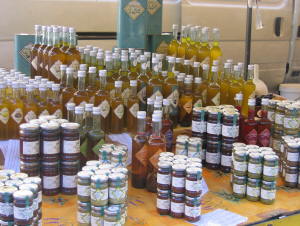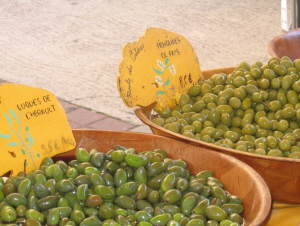Enjoy Olive Oil produced from your own Garden


Olive Mills and Private Harvesting
If you have one or more olive trees, you could come away from a private olive mill or a cooperative with a litre of your own olive oil for 7-8 kg of olives.
According to the variety of olive, you will need to pick your olives between mid November to mid January. The lucques (gourmet variety among olives), the verdale and the olivière varieties are picked from November, the picholine in December and January.
The time to pick is important – when they are turning black and contain the most oil. You must never use fallen olives, they will add oxygen and give you inferior quality oil. You have until 20 January to deliver your olives to a cooperative, and between 15 –30 January for a private mill. It is advised to store them in boxes with aeration holes and to sort them. They should be fresh and all leaves and pebbles removed. It is best to deliver them to the mill on the day of picking, as they cannot be stored more than 2-3 days after harvesting. It is possible to get together with neighbours to increase your quantity of oil produced. The minimum needed in order to go to a mill is 1 kg. It is best to check with your nearest mill as to the minimum amount they will accept.

lucques and picholine olives
Once you arrive at the olive mill, your olives will be weighed and you will be given a reference number to take away with you. In a private mill, a couple of days later, your oil will be ready for you. In a cooperative mill, the oil needs to rest during February, after which it is filtered. You can collect it in March for your own use or leave part of your harvest at the cooperative for sale.
How much does this cost?
For a private mill, you will pay around 0.35€ to 0.40€ including tax per kilo of olives. In a cooperative, it is obligatory for you to become a member. The cost of membership and pressing at the cooperative will cost around 2.02€ per kilo to 3.45€.
How do they produce the oil?
The mill extracts the oil from the olives, in stages and by both mechanical and natural methods, washing them and removing the leaves. Then the liquid matter is separated from the solids. The liquid passes into a centrifuge to separate the oil from water, and finally, the oil is filtered and bottled or stored in plastic containers.
How much does one tree produce?
Depending on the variety of oliveand the age of the tree, an olive tree can produce 25 kg of fruit, so that ten trees will produce around 200 kg, or 25 litres of oil.
Where can I take my olives?
Cooperatives°Huilierie de Clermont l’Hérault – 04 67 96 10 36
° Cooperative at Pignan – 04 67 47 70 22
Private Mills
Domaine de l’Oulivie at Combaillaux _ 04 67 67 07 80
Moulin de la Garrigue, Saint-André-de-Sangonis – 04 67 57 65 66
Moulin ‘Lo Moulinet’ at Puisserguier – 04 67 01 64 28
Huilierie du Pont du Gard, à Collorgues (min 300 kg of olives!) – 04 66 81 21 13
Moulin des Costières, near Saint-Gilles – 04 66 87 42 43 www.moulin-des-costieres.com
Moulin de Villevielle, near Sommières 154, Ave des Cévennes
30250 Sommières Tél: 04 66 80 03 69
Moulin des Bouviers, Gallician RN 572, tel 04 66 73 33 21
Moulin à l’Huile Paul Brunel, Saint-Césaire, Nimes Tel 04 66 84 05 54
Moulin de Beaufort, Domaine de Beaufort, Vestric-et-Candiac, Tel 04 66 88 30 13
If you have enjoyed this article, you might like to subscribe to our FREE newsletter which comes out every month with tips about property and life in the Region. Type in your email to subscribe:
Share to: Facebook Twitter LinkedIn Email
More in garden, languedoc, tax
By FrenchEntrée
Leave a reply
Your email address will not be published. Required fields are marked *



